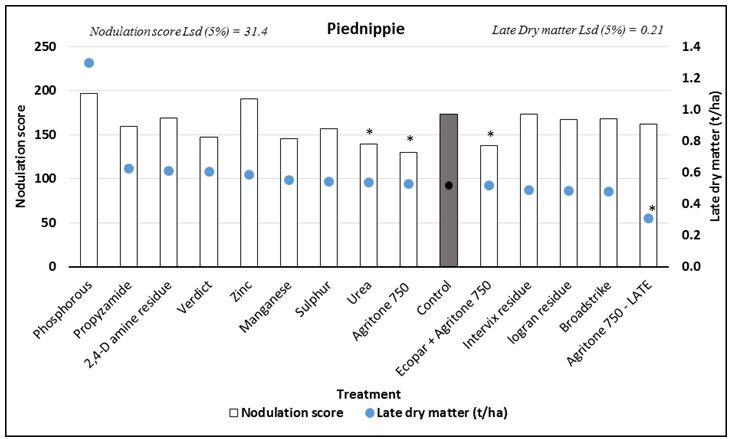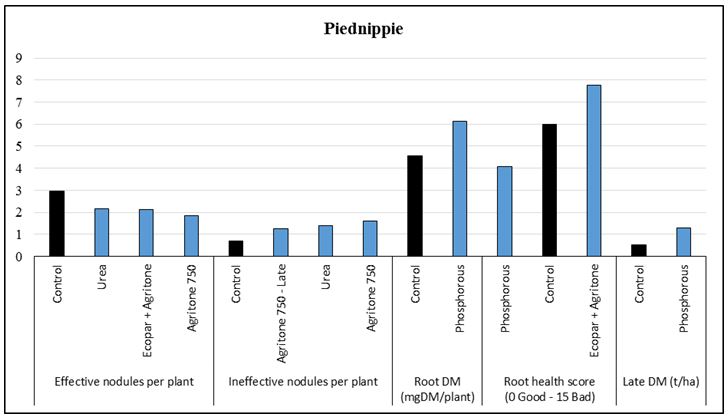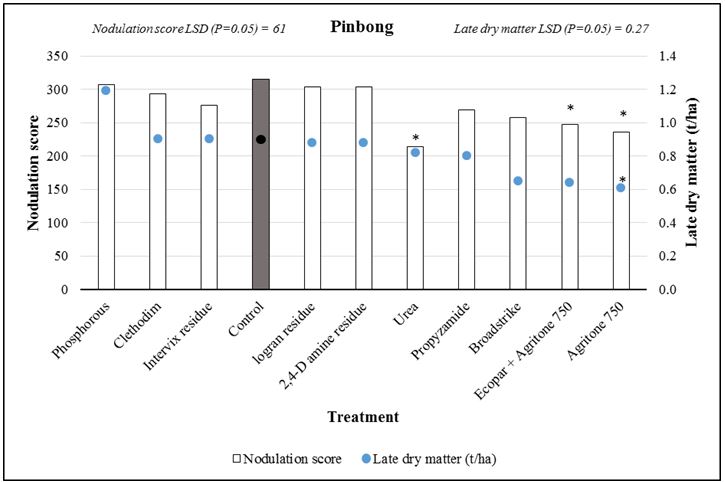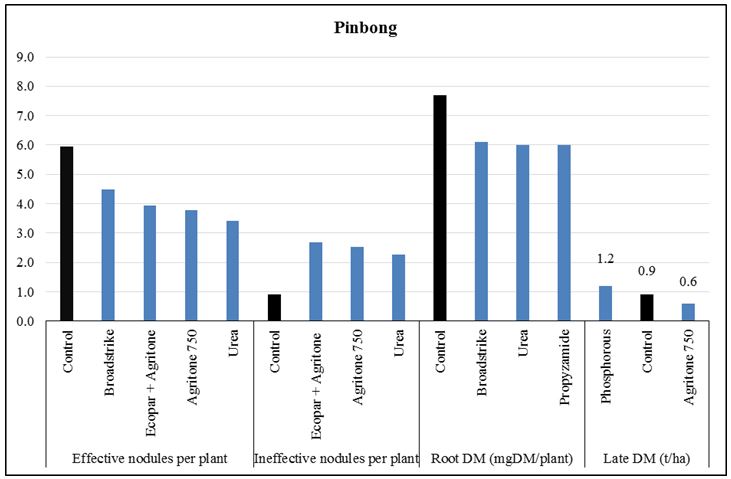Identifying the causes of unreliable nitrogen fixation by medic based pastures
Author: Brian Dzoma (SARDI, Minnipa Agricultural Centre), Ross Ballard (SARDI, Waite Research Precinct), Nigel Wilhelm (SARDI, Minnipa Agricultural Centre; SARDI, Waite Research Precinct) and Ian Richter (SARDI, Minnipa Agricultural Centre). | Date: 18 Aug 2016
Background
Annual medics (Medicago spp.) are self-regenerating pasture species that are well suited to crop rotations on neutral to alkaline soils. In southern Australia's semi-arid agricultural zones, medics provide feed for livestock, improve soil fertility through nitrogen (N) fixation and act as a disease break for many cereal root pathogens. Current farming systems are facing a decline in soil fertility under intensive cereal and canola cropping, and reports of lowering protein levels in wheat have become common throughout the cropping districts of southern Australia, including those where medic-based pastures are the most common.
Many medic pasture phases are now being managed to produce vigorous medic dominant pastures using a range of herbicides and pesticides to control weeds and pests. However, it appears that some of these pastures are not producing high N reserves for the following cereal crops. The broad aim of this South Australian Grains Industry Trust (SAGIT) funded project is to assess the impact of soil nutrition, current herbicides, adjuvants and rhizobial inoculants on N fixation by medics under field conditions typical of the upper Eyre Peninsula. These results should also be relevant to other low rainfall Mallee systems.
Materials and methods
Two replicated field trials were established in different biophysical regions of the Eyre Peninsula; one representative of typical mallee environments in SE Australia (Pinbong, latitude 32° 48' 32"S, longitude 135° 17' 36" E) and an extreme scenario, on a grey highly calcareous sandy soil (Piednippie, latitude 32°45'31"S, longitude 134°24'35"E). Background rhizobia populations, soil moisture and soil fertility were determined prior to seeding. Treatments to simulate herbicide residues (Table 1) were imposed on 28 April 2015 and the trials were later sown on 13 May 2015 (Pinbong) and 14 May 2015 (Piednippie) with all nutrition treatments applied at sowing.
Both trials were sown as a split plot design with the main plots being two contrasting and commercially popular medic varieties (Angeland Herald), and management options (nutrition, herbicides and inoculants) applied to both varieties. Post emergence herbicide treatments were applied after the third trifoliate leaf stage on 8 July 2015 (Pinbong) and on 30 July 2015 (Piednippie) at a water rate of 100 L/ha, with the exception of a late Agritone 750 treatment that was later imposed when medic plants were 5-7cm in diameter (24 August 2015). Plots were kept weed free as much as possible.
Table 1: Treatment details.
| Treatment | Active ingredient | Chemical group | Application rate (units/ha) |
|---|---|---|---|
| Post-emergence | |||
| Agritone 750 | 750 g/L MCPA (as dimethylamine salt) | I | 330 ml |
| Broadstrike | 800 g/kg Flumetsulam | B | 25 g + Uptake oil |
| Ecopar | 20 g/L Pyraflufen-ethyl | G | 400 ml |
| Agritone 750 | 750 g/L MCPA | I | 330 ml |
| Propyzamide 500 WG | 500 g/kg Propyzamide | D | 1000 ml |
| Verdict* | 520 g/L Haloxyfop | A | 75 ml + uptake oil |
| Clethodim | 240 g/L Clethodim | A | oil |
| Agritone 750-Late | 750 g/L MCPA (as dimethylamine salt) | I | 330 ml |
| Chemical residues (rates below label recommendations to stimulate residues from previous crop program) | |||
| Intervix | 33 g/L Imazamox; 15 g/L Imazapyr | B | 5 ml |
| Logran | 750 g/kg Triasulfuron | B | 0.125 g |
| 2, 4-D Amine | 625 g/L 2, 4-D (as dimethylamine salt) | I | 10 ml |
| Control | No inoculum, no fertiliser, no herbicide | ||
| Nutrition | Delivered as. | ||
| Nitrogen | Urea | 100 kg | |
| Phosphorous | Phosphoric acid | 10 kg | |
| Sulphur | Gypsum | 100 kg | |
| Zinc | Zinc sulphate | 2 kg | |
| Manganese | Manganese sulphate | 3 kg | |
*Verdict applied at Piednippie and Clethodim at Pinbong.
Sampling at the end of September 2015 estimated medic productivity and samples were used to estimate N2-fixation by the 15N natural abundance technique. The number of viable nodules, root health and root weight had been measured prior to this time. Contribution to N reserves in the soil was also measured by sampling for mineral N in the root zone in autumn (March) 2016.
Results
Cold conditions after sowing mid-May slowed establishment and early dry matter production. While there were subtle differences in the performance of the Herald strand medic and its mutant hybrid Angel (which has tolerance to sulfonylurea herbicide residues), larger differences were measured between herbicide and nutrition treatments. Hence results are presented as the average of both varieties. Plant density was not affected at either site by the treatments imposed, including the herbicide residue simulations.
Piednippie
A growth response to phosphorous (P) and zinc (Zn) was visible during the early stages of the trial. However, when measured, only P significantly increased shoot dry matter (DM) compared to the control, 1.3t/ha compared with 0.52t/ha, respectively (Figure 1). In terms of late dry matter, only Agritone 750 sprayed late reduced dry matter (DM), by 40 per cent and the effect was clearly visible in the trial. Medic nodulation scores (measured approximately eight weeks after sowing) were lower for the Agritone 750, Ecopar + Agritone 750 and urea treatments compared to the control. No treatments increased nodulation score compared to the control (Figure 1).

Figure 1: Nodulation scores and late dry matter (t/ha) for medic grown at Piednippie 2015.
Nodulation score is a calculated value that takes account of the number, location and appearance of nodules on the root system. Higher values indicate better nodulation.
*Significantly lower than the control (P<0.05)
Urea, Agritone 750 and Ecopar + Agritone 750 proved to be detrimental to nodulation, with lower numbers of effective nodules and higher numbers of ineffective nodules per plant (Figure 2). Phosphorous also proved to be the stand out treatment with the highest nodulation score, late DM, effective nodules per plant, root DM; and the best root health score (4.1). The Ecopar + Agritone mix had the worst root health score (7.8), which was substantially more than the control (6.0).

Figure 2: Treatments that are significantly different (P<0.05) from the control at the Piednippie site in 2015 for traits measured as listed on the x-axis.
Pinbong
Plant populations (plants/m2) for both sites were almost the same, Pinbong (136) and Piednippie (135). However the Pinbong site germinated and established earlier than the Piednippie site because of differences in soil type. These differences ultimately affected the performance of the medics and the Pinbong site produced more herbage (0.83t DM/ha) than Piednippie (0.58t DM/ha). The effect of nutrition treatments on the medic was not as visually pronounced as it was at Piednippie, nonetheless, in terms of dry matter the P treatment was the only treatment substantially better than the control with 1.2t DM/ha (Figure 3). Agritone 750 reduced late DM by 32 per cent from the control. Nodulation scores for Agritone 750, Ecopar + Agritone 750 and urea treatments were lower than the control, however, no other treatments performed consistently better than the control (Figure 3).

Figure 3: Nodulation scores and late dry matter (t/ha) for Pinbong 2015.
*Significantly lower than the control (P<0.05)
The number of effective nodules per plant was reduced by Broadstrike, Agritone 750, urea and Ecopar + Agritone 750 (Figure 4). These treatments, apart from Broadstrike, resulted in a corresponding increase in the number of ineffective nodules, with Ecopar + Agritone 750 causing the medic to have the most number of ineffective nodules. Root DM (mg DM/plant) was decreased by urea, Broadstrike and Propyzamide, with all three reducing root DM/plant by about 22 per cent compared to the control. Note that the latter two chemicals did not affect late DM on the grey calcareous sand at Piednippie.

Figure 4: Treatments that are significantly different (P<0.05) from the control at the Pinbong site in 2015 for traits measured as listed on the x-axis.
Plant and soil nitrogen
At Pinbong, measures of plant nitrogen from the 15N natural abundance analysis showed that there was no significant response by the different medic varieties or the treatments imposed on them in terms of total N (kg/ha) or fixed N (kg/ha and kg/t DM). The percentage of nitrogen fixed at this site was greater than 90 per cent and N fixed per tonne of dry matter was about 24kg N/t DM (Table 2). These amounts were higher than at Piednippie (65 per cent N fixed and 19kg N/t DM) (Table 2). At Pinbong, the amount of N fixed (kg/ha) ranged from 15kg/ha (Agritone 750 treatment) to 26kg/ha (plus P treatment).
Table 2: Fixed N (kg/ha) and N fixed per ton of dry matter (kg/tDM) at Piednippie and Pinbong 2015
| Site | Fixed N (kg/ha) | Fixed N (kg N/t DM) | Total N (kg/ha) |
|---|---|---|---|
| Pinbong | 20.5 | 23.8 | 22.1 |
| (15-26) | (22-25) | (16-28) | |
| Piednippie | 10.9 | 18.8 | 16.1 |
| (5-23) | (17-25) | (9-33) |
Figures in brackets show the min. and max. values of the N measure.
At Piednippie there were significant treatment effects on fixed N, kg/ha (P<0.001); fixed N, kg/tDM (P<0.05) and total N, kg/ha (P<0.001). Phosphorous addition was the only treatment that increased the amount of fixed N (23kg/ha) compared to the control (9kg/ha), whereas the late Agritone treatment (5kg/ha) was the only treatment to fix significantly less N than the control.
Soil mineral N was not significantly affected by the treatments in either the 0 – 10 cm or 10 – 60 cm soil depth zones, at both sites. Total mineral N (0 – 60 cm) was higher at Pinbong (101 kg N/ha) than at Piednippie (78 kg N/ha).
Discussion
The value of legume pastures in farming systems is strongly influenced by how well they grow and fix N. High shoot DM yields mean high carrying capacity, better economic returns and potentially more N added to the system via N-rich legume residues from N fixation. On average, 20kg N/ha is fixed for every tonne of legume shoot dry matter produced (GRDC Nitrogen fixation factsheet, 2014). Therefore, a medic pasture producing 3t/ha of DM might be expected to produce up to 60kg N/ha in one year, which is equivalent to 140kg/ha of urea. Variations around these average values are commonly measured. Treatments or conditions affecting nodulation, N-fixation or dry matter production can have positive or negative effects on the amount of N that is actually fixed.
P reserves (Colwell P, 0-10 cm) at Piednippie and Pinbong prior to sowing were 16mg/kg and 21mg/kg, respectively. Phosphorous (P) had a large and positive effect on shoot dry matter at both sites. There was a 33 per cent and 150 per cent increase in shoot DM at Pinbong and Piednippie respectively, resulting from the application of 10 units of fluid P/ha. If similar increases were achieved in a regenerating paddock with 3t/ha of shoot DM, this would translate to between 20 and 90kg/ha of extra fixed N. These amounts of fixed N are equivalent to 43 and 196kg/ha of urea, capturing an extra $11 to $51/ha value from the pasture phase (assuming the cost of urea is $258/tonne), (Indexmundi, 2016). These gains are greater if the comparison is made to some of the herbicide affected treatments.
Our trials indicated that there can be a shoot DM penalty if certain herbicides are used as part of the weed control program during the pasture phase. There was a 32 per cent and 40 per cent shoot DM penalty from using Agritone 750 at Pinbong and applying it late at Piednippie. Using the same methodology applied in the previous paragraph, these production penalties translate to 19kg/ha and 24kg/ha less fixed N (equivalent to 42kg/ha and 52kg/ha of urea). This penalty alone could substantially reduce the value of the weed control achieved by Agritone. Measures of reduced nodulation suggest that these loss estimates will likely increase when the N-fixation data is included.
Significant treatment effects at Piednippie highlight the potential to improve (P treatment) or reduce (late Agritone treatment) the amount of fixed N added to the farming system. When compared to the control treatment (9kg/ha), the phosphorous treatment fixed 155 per cent more N (23kg/ha) and the late Agritone treatment fixed 44 per cent less N (5kg/ha). These findings are consistent with the data trends at Pinbong, despite the lack of statistical significance at that site. Whether the P responses indicate a direct stimulation of N fixation or more general effect on plant growth is unclear, but nonetheless highlights a level of P deficiency at the sites. This could be masking the true extent of some herbicide effects. The fact that differences in plant N and fixed N were not reflected in soil N levels is possibly a result of the relatively low levels of pasture growth, and therefore, N addition to the system in the year of pasture establishment is recommended. More time may also be needed for the plant residues to mineralise.
These preliminary results show that there is an advantage to be realised in terms of pasture DM through the use of phosphorous when establishing new medic pastures, even on paddocks of moderate P reserves. The timing of application can also have negative consequences especially when chemicals are applied late in the season. Chemical weed control remains a vital component of integrated weed management in a cropping system; however, some chemicals may have a negative effect on pasture DM and more specifically on nodulation and N-fixation when applied during the medic pasture phase. These effects must be balanced against the value of the weed control they provide.
Acknowledgements
A special thanks to Greg Scholz and Brent Cronin for allowing us to conduct the trials at their properties, and Andy Bates (Bates Ag Consulting) for his input in this project. This project is supported by funding from SAGIT (SARDI 1515: Identifying the causes of unreliable N fixation by medic based pastures).
References
GRDC (2014) Nitrogen fixation factsheet. Southern and Western Regions. Nitrogen fixation of crop legumes: Basic principles and practical management.
Indexmundi (2015) Accessed on 27/07/2016.
Contact details
Brian DzomaP O Box 31 Minnipa SA 5654
08 8680 6205, 0429 799 902
brian.dzoma@sa.gov.au
Was this page helpful?
YOUR FEEDBACK
